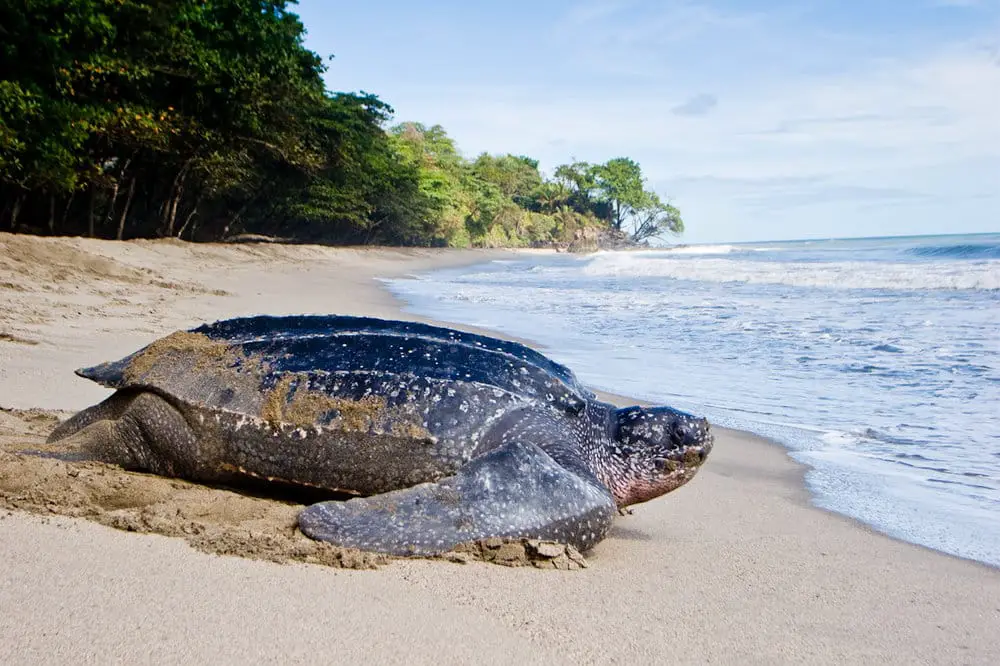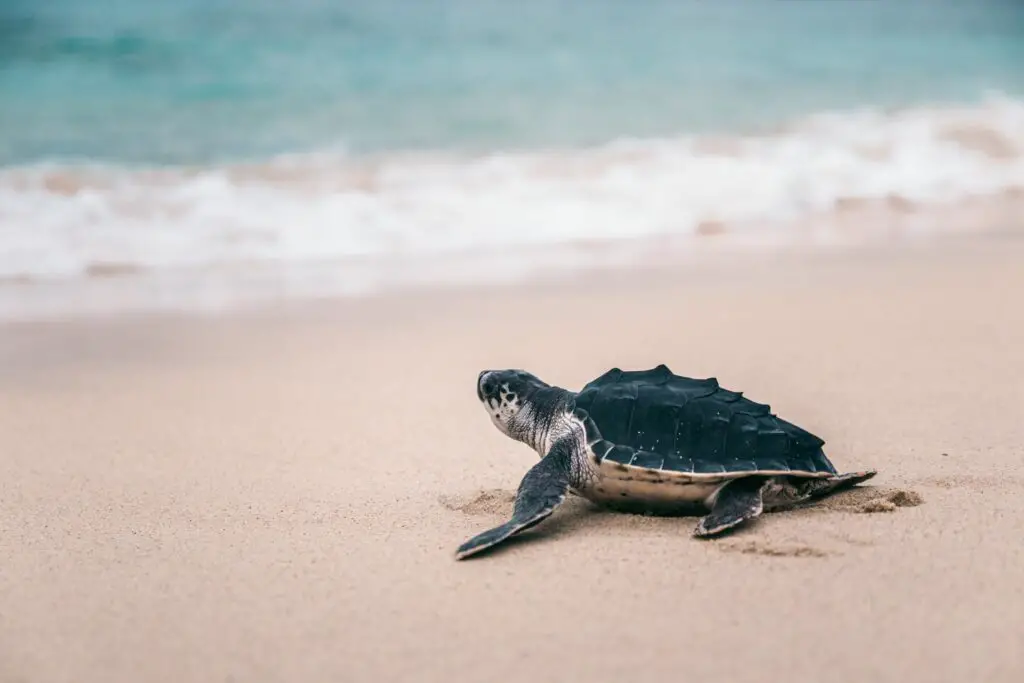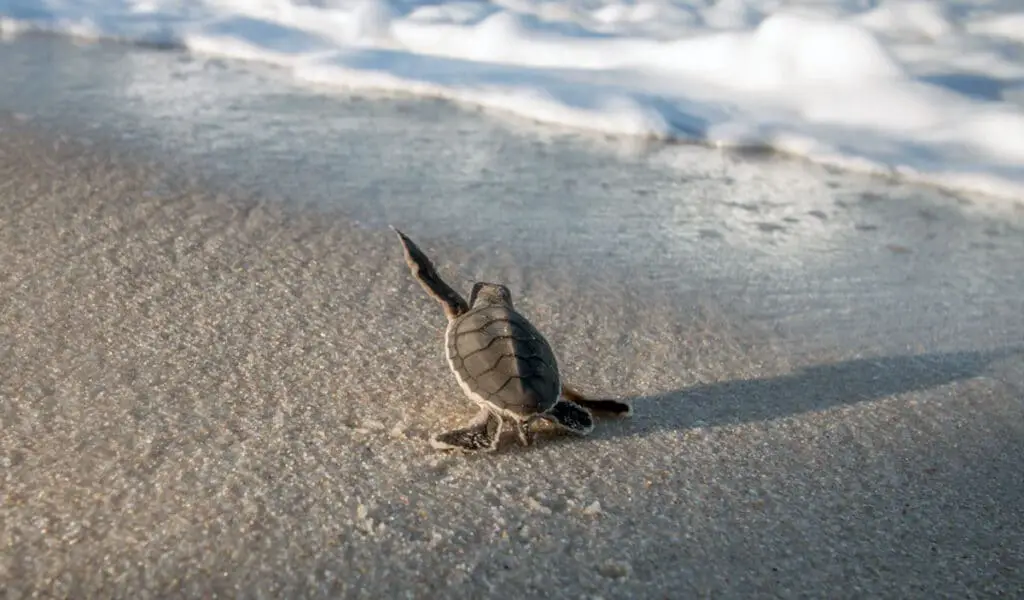What Are Sea Turtles Predators

Introduction
What Are Sea Turtles Predators: Sea turtles, ancient and magnificent creatures that have roamed the oceans for millions of years, are not exempt from the age-old struggle for survival. While they are marvels of evolution, their existence is marked by a constant battle against a diverse array of predators.
In the vast expanse of the world’s oceans, sea turtles face a perilous web of threats. Some of their most formidable foes come from within the depths themselves. Apex predators like sharks, including species such as tiger sharks and great white sharks, pose significant dangers to sea turtles, especially during their vulnerable hatchling stage. These powerful hunters can effortlessly capture a sea turtle in their razor-sharp jaws.
Sea turtles are not only at risk from below but also from above. Numerous seabirds, like seagulls and frigatebirds, eagerly target sea turtle hatchlings as they make their first treacherous journey from nest to sea. Their relatively exposed and defenseless condition makes them easy prey for these aerial predators.
Additionally, crocodiles and large fish species like barracudas lurk in coastal waters, where sea turtles often forage, making these reptiles susceptible to ambush attacks. However, sea turtles have managed to persist and adapt to the presence of these predators through various survival strategies and behaviors.
Understanding the complex interplay between sea turtles and their predators is crucial for conserving these remarkable creatures in our rapidly changing world. This exploration will delve deeper into the fascinating world of sea turtles and the predators they contend with in their ongoing struggle for survival.

What are sea turtles predators?
Natural Predators
Tiger sharks, in particular, are known for eating sea turtles. Killer whales have been known to prey on leatherback turtles. Fishes, dogs, seabirds, raccoons, ghost crabs, and other predators prey on eggs and hatchlings. More than 90% of hatchlings are eaten by predators.
Sea turtles contend with a wide range of natural predators throughout their lives. From the moment sea turtle hatchlings emerge from their nests and make their perilous journey to the ocean, they face threats from various quarters. Among the most formidable of these predators are sharks, including species like tiger sharks and great white sharks. With their powerful jaws and keen hunting instincts, sharks can easily capture sea turtles, particularly when they are young and vulnerable.
Above the surface, seabirds such as seagulls and frigatebirds pose a significant threat to sea turtle hatchlings. These aerial predators eagerly target hatchlings as they scuttle across the beach towards the safety of the sea. Their exposed and defenseless state makes them easy prey for these opportunistic birds.
Closer to the shore, in the shallow coastal waters where sea turtles often forage, threats continue in the form of crocodiles and large fish species like barracudas. These ambush predators lie in wait for an opportunity to capture a passing sea turtle.
In this intricate web of predator-prey relationships, sea turtles have evolved various survival strategies, such as their remarkable swimming abilities and the nesting behaviors that help safeguard their offspring. Understanding the challenges posed by these natural predators is essential for effective sea turtle conservation efforts in the face of increasing human-induced threats.
How do turtles stay safe from predators?
Camouflage, defensive strategies such as the release of irritating chemicals, and protective structures such as horns, claws, and jaws are examples of adaptations to promote survival. Turtles exhibit a wide variety of adaptations for survival.
Turtles employ a variety of ingenious strategies to evade and protect themselves from predators in their terrestrial and aquatic habitats. One of their most iconic defenses is their sturdy, protective shell. This shell acts as a shield, providing a barrier against potential threats. When threatened, many turtle species can retract their head, limbs, and tail into their shell, rendering them nearly impervious to harm.
In aquatic environments, turtles’ mobility in water offers an advantage. They are agile swimmers, capable of swiftly escaping from underwater predators like alligators and large fish. Their streamlined bodies and strong flippers enable them to navigate quickly through their aquatic domains.
On land, while turtles may not be as agile, they often rely on camouflage and their ability to stay motionless to avoid detection by predators. Some species, like the box turtle, can even close their hinged shell tightly, making it difficult for a predator to pry them open.
Turtles also use their senses to detect potential threats. They have keen eyesight, and their sense of smell helps them detect the presence of nearby predators or sources of danger.
While turtles have evolved these remarkable defenses against natural predators, they face growing threats from human activities, such as habitat destruction, pollution, and poaching. Conservation efforts are essential to ensure that these ancient and fascinating reptiles continue to thrive and contribute to the biodiversity of our planet.
What do the predators follow of the turtle?
The predators follow the scent of the turtles to eat their eggs.
The predators of the turtle are astute hunters, guided by a combination of instinct and learned behavior. These adept hunters primarily rely on keen senses to track down their shelled prey. Sight plays a crucial role, as turtles, though well-adapted to their aquatic environments, are not without vulnerabilities. Predators with sharp eyesight, such as birds of prey like eagles and hawks, often spot turtles basking on rocks or floating near the water’s surface.
However, it is the olfactory senses that truly distinguish predators in the pursuit of turtles. Some species, like alligators and crocodiles, possess highly developed olfactory systems, capable of detecting subtle chemical signals emitted by turtles. These reptilian hunters can discern the presence of a nearby turtle even when it remains concealed beneath the water’s surface.
Moreover, the sense of touch plays a role, particularly for aquatic predators like sharks and large fish. They rely on sensitive lateral lines to detect the vibrations and movements created by a turtle’s passage through the water, allowing them to close in on their target with stealth and precision.
In essence, the predators of turtles are a testament to the marvels of evolution, finely tuned to exploit every sensory advantage in their pursuit of these ancient creatures.
What can harm sea turtles?
Illegal harvesting, habitat encroachment, and pollution are only some of the things sea turtles must fight against to stay alive.
Sea turtles face a myriad of threats in their fragile marine habitats. Chief among these dangers is human activity. Pollution, particularly plastic waste, poses a grave risk to these gentle creatures. Ingesting or becoming entangled in plastic debris can lead to internal injuries, digestive blockages, and ultimately, death. The degradation of coastal habitats due to construction, tourism, and climate change disrupts nesting sites, making it increasingly challenging for turtles to successfully reproduce.
Another formidable peril arises from fishing practices. Turtles can become unintentional bycatch in nets and longlines, suffering injuries or drowning as a result. Additionally, poaching of turtle eggs and hunting for their meat and shells remains a prevalent issue in some regions, contributing to declining populations.
Climate change, with rising temperatures and sea levels, disrupts the delicate balance of marine ecosystems. Changes in temperature can alter the sex ratio of turtle hatchlings, affecting future generations. The loss of coral reefs, vital feeding and breeding grounds, further compounds these challenges.
Lastly, light pollution along coastlines can disorient hatchlings, leading them away from the safety of the ocean. They may become exhausted, dehydrated, or fall victim to predators.
Addressing these multifaceted threats requires concerted global efforts in conservation, sustainable practices, and heightened awareness of the critical role sea turtles play in maintaining the health of our oceans.
How do sea turtles react to predators?
If an attack is imminent, sea turtles have been seen turning their shell to the shark’s mouth as it approaches, thus preventing the shark from biting their flippers or soft tissues, and swimming fast in the opposite direction.
Sea turtles have evolved a range of adaptations to cope with predators in their marine environments. Their primary defense mechanism is their sturdy, protective shell, which provides a formidable barrier against many would-be attackers. When threatened, turtles instinctively retract their head, flippers, and tail into their shell, creating a nearly impenetrable fortress.
In the face of aerial predators like birds, turtles often seek refuge in the water. They are remarkably agile swimmers, capable of quick and graceful movements. This agility allows them to escape from predators in their natural element, using their powerful flippers to navigate with surprising speed.
When confronted by predators in the water, such as sharks or large fish, sea turtles employ evasive maneuvers. They may execute rapid bursts of speed, change direction abruptly, or even employ camouflage techniques by blending into their surroundings.
Some sea turtle species have developed a unique adaptation known as “crypsis,” where they bear physical characteristics or coloration that help them blend into their environment, making them less conspicuous to predators.
Overall, sea turtles exhibit a combination of defensive strategies, blending protective physical attributes with behavioral adaptations, enabling them to evade and deter predators in their quest for survival.
What are 5 interesting facts about turtles?
Top 10 facts about marine turtles
- There are seven species of marine turtle.
- Turtles don’t have teeth.
- They’re well ‘ard.
- Their young lives are a mystery.
- They can be ginormous.
- It’s survival of the fittest.
- They make some interesting noises.
- Sad but less salty.
Here are five fascinating facts about turtles:
- Ancient Lineage: Turtles are one of the oldest reptile groups on Earth, with a lineage dating back over 220 million years. They’ve witnessed the rise and fall of dinosaurs and have remained relatively unchanged in their basic body structure for millions of years.
- Unique Shells: Turtles are renowned for their shells, which are actually part of their skeleton. The upper part is called the carapace, while the lower part is the plastron. These shells provide excellent protection and can vary greatly in color, pattern, and size depending on the species.
- Aquatic Marvels: While many people associate turtles with land, the majority of species are actually highly adapted to life in the water. Sea turtles, for instance, spend the majority of their lives in the ocean and have specialized flippers for efficient swimming.
- Slow and Steady: While turtles aren’t known for their speed, their slow and steady approach to life is well-suited to their survival. They have impressive endurance and can cover great distances over time, making them well-adapted to their environments.
- Varied Diets: Turtles are diverse in their dietary preferences. While some are strict herbivores, munching on plants and algae, others are omnivores, feasting on a mix of plants and small aquatic animals like insects, fish, and crustaceans. This adaptability allows them to thrive in various habitats around the world.
These intriguing characteristics make turtles a remarkable group of creatures, worthy of admiration and protection.
How do sea turtles defend themselves against predators?
Sea turtles have evolved several remarkable defense mechanisms to protect themselves against a wide array of predators in their oceanic environments. Their primary line of defense is their hard, bony shell, which acts as a protective armor. This shell, or carapace, covers their back and provides a formidable barrier against potential threats. When threatened, sea turtles can retract their head and limbs into their shell, making it difficult for predators to gain access to their vulnerable parts.
In addition to their physical defenses, sea turtles have evolved impressive swimming capabilities. They are agile and graceful swimmers, capable of rapidly propelling themselves through the water. This agility allows them to escape from many underwater predators like sharks and larger fish species. Their streamlined bodies and powerful flippers enable them to navigate swiftly and change direction, making it challenging for predators to catch them.
Another strategy sea turtles employ is avoiding predators through camouflage and behavior. Some species, like the loggerhead sea turtle, have shells with a coloration that matches the surrounding environment, helping them blend in and avoid detection. Additionally, sea turtles often feed and rest in areas where their predators are less abundant, reducing their exposure to potential threats.
While these defenses have helped sea turtles survive in their natural habitats, they face increasing challenges from human-induced threats, including pollution, habitat destruction, and accidental bycatch in fishing gear. Conservation efforts are essential to protect these ancient mariners and ensure their continued survival in our oceans.
Are there conservation efforts to protect sea turtles from predators and other threats?
There are extensive conservation efforts in place to protect sea turtles from a variety of threats, including predators and human activities. Predation on sea turtle nests by animals like raccoons, birds, and crabs can significantly impact hatchling survival. To combat this, many coastal regions implement nest protection programs.
Human activities pose a significant threat to sea turtles as well. Habitat destruction, pollution, and climate change all contribute to their declining populations. Conservation organizations and governments worldwide are working tirelessly to address these issues. They establish marine protected areas and implement regulations to minimize human disturbance in sea turtle nesting and foraging habitats.
Efforts to reduce bycatch in fishing operations, particularly through the use of turtle-friendly gear, have also gained momentum. Public awareness campaigns educate people about the importance of these ancient creatures and their fragile ecosystems, encouraging responsible behavior and reducing demand for turtle products.
Numerous conservation initiatives are actively striving to protect sea turtles from predators and various human-induced threats, aiming to ensure the survival of these remarkable marine species for generations to come.

Conclusion
The array of predators they encounter throughout their life stages highlights the intricacies of their existence. From the moment hatchlings embark on their perilous journey from nest to sea, they face threats from above and below. Sharks, formidable predators of the deep, can snatch even adult sea turtles with their powerful jaws, while seabirds lie in wait to prey on vulnerable hatchlings. Closer to shore, crocodiles and predatory fish add to the complex matrix of threats.
Despite these daunting challenges, sea turtles have persisted for millions of years through a combination of evolutionary adaptations, behavioral strategies, and sheer determination. These ancient mariners have captivated our imaginations and inspired conservation efforts worldwide. Understanding the role of predators in their lives underscores the delicate balance of marine ecosystems.
Efforts to protect sea turtles must extend beyond the threats they face in the natural world. Human-induced dangers, such as habitat destruction, pollution, and unsustainable fishing practices, pose equally significant risks to these remarkable creatures. By comprehensively addressing both natural and anthropogenic threats, we can ensure the continued existence of sea turtles and their invaluable contribution to the health and diversity of our planet’s oceans.



